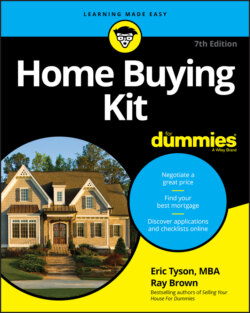Читать книгу Home Buying Kit For Dummies - Eric Tyson - Страница 53
Mortgage payments
ОглавлениеIn Chapter 6, we discuss selecting the best type of mortgage that fits your particular circumstances. In the meantime, you must still confront mortgages (with our assistance) because mortgages undoubtedly constitute the biggest component of the total cost of owning a home.
Start with the basics: A mortgage is a loan you take out to buy a home. A mortgage allows you to purchase a $200,000 home even though you have far less money than that to put toward the purchase.
With few exceptions, mortgage loans in the United States are typically repaid over a 15- or 30-year time span. Almost all mortgages require monthly payments. Here’s how a mortgage works. Suppose that you’re purchasing a $200,000 home and that (following our sage advice, appearing later in this chapter) you have diligently saved a 20 percent ($40,000, in this example) down payment. Thus, you’re in the market for a $160,000 mortgage loan.
You sit down with a mortgage lender who asks you to complete a volume of paperwork (we navigate you through that morass in Chapter 7) that dwarfs the stack required for your annual income tax return. Just when you think the worst is over (after the paperwork blizzard subsides), the lender proceeds to give you an even bigger headache by talking about the literally hundreds of mortgage permutations and options.
Don’t worry — we can help you cut through the clutter! Imagine, for a moment, a simple world where the mortgage lender offers you only two mortgage options: a 15-year fixed-rate mortgage and a 30-year fixed-rate mortgage (fixed-rate simply means that the interest rate on the loan stays fixed and level over the life of the loan). Here’s what your monthly payment would be under each mortgage option:
$160,000, 15-year mortgage @ 4.75 percent = $1,245 per month
$160,000, 30-year mortgage @ 5.00 percent = $859 per month
As we discuss in Chapter 6, the interest rate is typically a little bit lower on a 15-year mortgage versus a 30-year mortgage because shorter-term loans are a little less risky for lenders. Note how much higher the monthly payment is on the 15-year mortgage than on the 30-year mortgage. Your payments must be higher for the 15-year mortgage because you’re paying off the same size loan 15 years faster.
But don’t let the higher monthly payments on the 15-year loan cause you to forget that at the end of 15 years, your mortgage payments disappear, whereas with the 30-year mortgage, you still have 15 more years’ worth of monthly payments to go. So although you have a higher required monthly payment with the 15-year mortgage, check out the difference in the total payments and interest on the two mortgage options:
| Mortgage Option | Total Payments | Total Interest |
| 15-year mortgage | $224,064 | $64,064 |
| 30-year mortgage | $309,312 | $149,312 |
Note: In case you’re curious about how we got the total interest amount, we simply subtracted the amount of the loan repaid ($160,000) from the “Total Payments.” Also, the monthly payment numbers previously cited, as well as these total payments and interest numbers, are rounded off, so if you try multiplying 180 or 360 by the monthly payment numbers, you won’t get answers identical to these numbers.
With the 30-year mortgage (compared with the 15-year mortgage), because you’re borrowing the money over 15 additional years, it shouldn’t come as a great surprise that (with a decent-size mortgage loan like this one) you end up paying more than $80,000 additional interest. The 30-year loan isn’t necessarily inferior; for example, its lower payments may better allow you to accomplish other important financial goals, such as saving in a tax-deductible retirement account. (See Chapter 6 for more information about 15-year versus 30-year mortgages.)
In the early years of repaying your mortgage, nearly all your mortgage payment goes toward paying interest on the money that you borrowed. Not until the later years of your mortgage do you begin to rapidly pay down your loan balance, as shown in Figure 3-1.
As interest rates increase, so does the time required to pay off half the loan. For example, at a 10 percent interest rate, paying off half of a given loan takes almost 24 years of the loan’s 30-year term.
